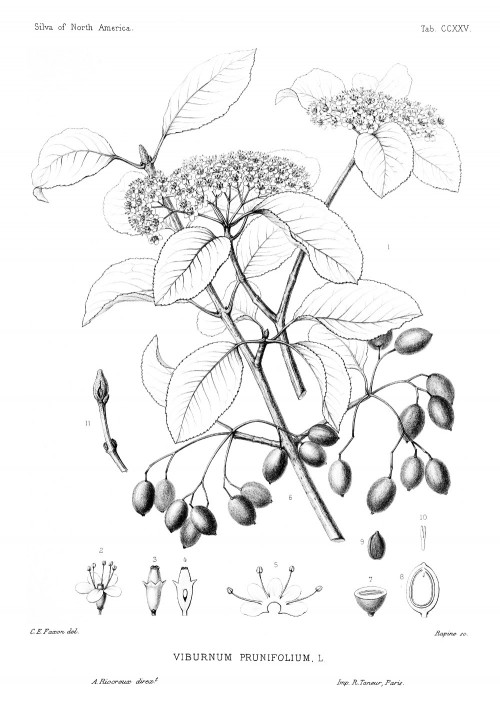Viburnum prunifolium L. - Adoxaceae - (formerly Caprifoliaceae) Black Haw, Amerikanischer Schneeball, Schwarze Hagebutte
Eastern North America: Deciduous shrub or small tree, 3-6m high; leaves elliptic, serrulate („plum-like“=„prunifolium !); small flowers; fruit a dark blue berry
„Viburnum prunifolium is especially a uterine sedative in threatened miscarriage. It is particularly indicated in habitual abortion, preventing an anticipated occurrence and permanently overcoming the habit. I have had practical experience extending over thirty years, and have perfect confidence in the agent based on repeated success.“
[Ellingwood, F., & Lloyd, J. U. (1919). American materia medica, therapeutics and pharmacognosy. Sandy, Oregon: Eclectic Medical Publications 564p. En First published Cincinatti, Ohio.] http://www.henriettes-herb.com/eclectic/ellingwood/viburnum-prun.html
Balck hawk stem bark (black haw bark - Viburni prunifolii cortex) is used to treat menstrual cramps, uterine pain and menstrual disorders, in traditional medicine also against morning sickness, symptoms of menopause, stomach cramps, colic, muscle spasms and high blodd pressure. Of the numerous chemical compounds known from the bark, aseculetin and scopoletin are known as muscolotropic spasmolytics. The bark of Viburnum opulus is also used to some extent.
[Medicinal Plants of the World. Ben-Erik Van Wyk and Michael Wink, Pretoria 2004, 339]
„Cortex Viburni Prunifolii consists of the dried root or stem, trunk or root bark of Viburnum prunifolium L…Odour: characteristically pungent, valerian-like; taste: astringent and bitter… Uses described in pharmacopoeias and well established documents: Orally for the treatment of dysmenorrhoea and asthma. Uses described in traditional medicine: Used to treat menstrual irregularities and nervous tension. Also used as
an antispasmodic, diuretic and tonic.“
[Ochoa Milián, H., Campos, O., López de León, E., Del Cid, J. R., Gil Faggiolly, S. L., Gil Faggiolly, S. L., … & Gazziero, D. L. P. (2009). WHO monographs on selected medicinal plants. Vol. 4 (No. F60-02). World Health Organization.] http://www.who.int/medicines/areas/traditional/SelectMonoVol4.pdf
The North America shrub Viburnum prunifolium is used in ethnomedicine because of its spasmolytic, sedative, and anti-asthmatic properties. Pharmacological assays of various purified fractions of Viburnum prunifolium methanolic extract were carried out on rabbit jejunum spontaneous contractions and on guinea-pig carbachol-precontracted trachea. 2′-O-acetyldihydropenstemide, 2′-O-trans-p-coumaroyldihydropenstemide, 2′-O-acetylpatrinoside, and patrinoside, induced both relaxant effect of rabbit jejunum spontaneous contractions and spasmolytic effect on guinea-pig carbachol-precontracted trachea. It is conluded that the iridoids play a significant role in the biological activity of Viburnum prunifolium.
[In vitro relaxant and spasmolytic effects of constituents from Viburnum prunifolium and HPLC quantification of the bioactive isolated iridoids., Cometa, M.F., Parisi, L., Palmery, M., Meneguz, A., Tomassini, L., Journal of ethnopharmacology, 123(2), 201-207, 2009]

Sargent, C.S., The Silva of North America, vol.5 t.225 (1892) [C.E. Faxon]
http://plantgenera.org/species.php?id_species=1060201
